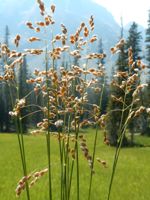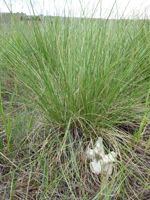Mon-Fri 9am - 5pm Mountain time
Rough Fescue vs Sweetgrass
Anthoxanthum hirtum/Anthoxanthum nitens (Hierochloe odorata))
Festuca campestris
CUSTOM GROW
CUSTOM GROW
Sweetgrass is a cool-season perennial grass best known for its sweet, vanilla-like fragrance. The scent comes from coumarin in the leaves, which is pleasant to humans but has a bitter taste that makes the plant less appealing to deer and other herbivores. As a cool-season grass, Sweetgrass grows most vigorously in spring and fall, slowing or even going dormant during the heat of summer.
It spreads quickly through creeping rhizomes and can be difficult to remove once established, so it is best planted in areas where its spread will not cause problems. Due to its deep, vigorous root system and preference for moist soils, Sweetgrass is especially useful for erosion control, soil stabilization, riparian plantings, and naturalization projects.
Note: Sweetgrass was formerly classified under the scientific name Hierochloe odorata and its subspecies. The subspecies found in Canada are currently considered two distinct species: Anthoxanthum hirtum, which is native across Canada, and Anthoxanthum nitens, which is native to Eastern Canada. Because these two species are alike and share many overlapping common names, they are often considered as only one species.
Rough Fescue is a native perennial bunchgrass valued for its tall, dense clumps and long-lived growth. Adapted to cold climates and nutrient-poor soils, it is a defining species of northern prairie and montane grasslands. In western Canada and the northern Rocky Mountains, Rough Fescue is considered a keystone species because it shapes plant communities, stabilizes soils, and supports ecosystem resilience.
It is a cool-season grass, growing most actively in spring and fall and slowing during the heat of summer. Rough Fescue is highly regarded as forage for wildlife and livestock, with elk, deer, and other grazing animals favoring it. Taller than many other fescue species, it is well-suited to prairie restoration, erosion control, and naturalization projects where it supports both biodiversity and long-term ecosystem health.
Sweetgrass Quick Facts
Rough Fescue Quick Facts
Toxicity: toxic if large amounts ingested

